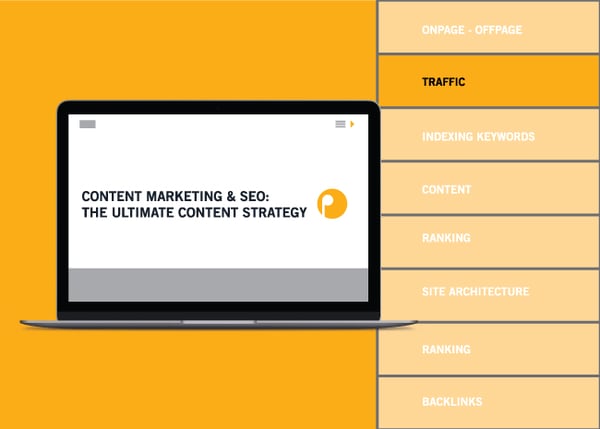You have a great idea for a new business. You have the products ready, the website built, the concepts are churning; but where are all the customers? You know your audience is out there — you’ve probably even spent a few hours researching and identifying them — but they don’t seem to be finding your site nor your products.
What do you do?
This is where content marketing and search engine optimization (SEO) really shine, as a mix of both allows your audience to find you.

Taking on content marketing and SEO on your site may seem like a daunting task that may require the help of experts, but the most essential aspects of SEO actually don’t require a whole lot of specialized knowledge. All you need is a website, an audience, and a plan to target and engage your customers.
Let’s explore what content marketing entails, how SEO works in conjunction with content marketing, and how you can utilize a basic understanding of both to create the perfect content strategy.
What is Content Marketing?
Content marketing is the bread to SEO’s butter. They both can exist by themselves, but when combined together, they make a delicious treat.
First, let’s define content marketing in its most basic sense. Content marketing is a form of marketing that requires the creation and sharing of materials that are intended to stimulate interest or answer questions related to a topic, with the shared goal of selling products and providing valuable information about the industry. This can include:
- Videos.
- Blog posts.
- Photos.
- Infographics.
- Animations.
- Social media posts.
- Etc.
Content marketing has been around longer than the internet, but the internet has truly allowed content marketing to shine and begin to dominate over most other marketing tactics.
Prior to the internet, content marketing could be seen through commercials or ads in the newspaper. It also bleeds into our entertainment, as “product placement” in movies can be a form of content marketing.
Now, thanks to the internet and targeted SEO tactics, we are inundated with content marketing from nearly every side — sometimes literally, as both sidebars on your browser may be chock-full of ads.
However, content marketing doesn’t have to be a big venture, even if it does take up most of your marketing budget, and is hard work. Some of the best examples of content marketing are blog posts or videos that answer very basic questions — such as “who, what, where, when, and how” type questions — that are tangentially related to your business.
Content marketing doesn’t have to be especially creative or niche, even if your product is niche. All it needs to do is share information on a topic related to your business that can attract interest and help retain audiences.
What is SEO Content?
Another form of marketing is search engine optimization, or SEO. Defined in the most basic sense, SEO is the process of creating online visibility for a site by purposefully optimizing the site to be “crawlable” or visible to search engines.
Search engines function by “crawling” the web, identifying information, and then compiling that information in their search engine index in order to best answer searcher queries.

SEO can get complex rather fast, as it focuses a lot on the technical inner-workings of HTML coding, search engine guidelines, and more.
However, the basics are generally understandable for beginners, and are aimed at aiding a site’s visibility on search engines like Google, Bing, or other search engines. Even Google’s SEO Starter Guide emphasizes that SEO often comes in the form of small modifications to a site that many site owners may already be familiar with but not utilizing properly.
SEO content, then, is content that is created specifically to appeal to searchers that may be looking for answers through a search engine. When done correctly, SEO content is often indistinguishable from other online content marketing. However, SEO content focuses very specifically on the technical side of appealing to search engines. As Google’s SEO Starter Guide explains:
“Search Engine Optimization is about helping search engines understand and present content.”
When creating a content marketing strategy that is focused on SEO, utilizing both targeted SEO content and traditional content can really make a difference. The two have the ability to truly benefit and complement each other when integrated properly into a marketing campaign.
Integrate Your SEO and Content Marketing Strategies
Yet, you may be wondering: how do you build a successful marketing strategy that integrates both SEO and traditional content?
Where the two disciplines of SEO and content marketing meet is the creation of authoritative content that covers a wide variety of topics related to your niche. Google and other search engines value sites and blogs that cover a wide depth and breadth of well-written and well-optimized content, and it’s what searchers want to see, as well.

Content creation is a difficult process. It requires keyword research, audience research, careful topic planning, and an exceptional grasp of not only your subject matter, but writing and editing skill as well. It takes up a lot of time and requires a lot of SEO knowledge to fit content into an SEO strategy.
SEO may be intended to make websites more friendly for search engine crawlers, but website owners shouldn’t create content that only appeals to search engines. Content also needs to be informative and engaging for a human audience.
The mark of a successful content marketing and SEO-focused blog is if the content can be and is used by searchers and search engines, alike.
Satisfy Searcher Intent
Oftentimes the most powerful component of SEO content are the targeted keywords that signal to search engines what the business does, what audience they are hoping to target, and how they can answer searcher questions.
Keywords can be singular words or whole phrases, such as “define keyword optimization,” and sites can utilize this information to create content that is optimized to answer these questions.
Understanding keywords is more than just working out what people are searching for; you also need to be mindful of the intent behind those searches. Is your audience interested in learning more about the industry you work in? Are they worried about a specific “pain point” that your product can help them solve?
Understanding or speculating the intention behind these search queries can help you create content that not only helps them answer their questions, but delivers results in the searches, as well.
Is your content performing in search? Download this free checklist to ensure your content is optimized for search success!
Start your research by defining your audience based on the keywords you plan to target. Once you’ve defined them, consider their pain points or interests, and write your content based on that information.
Build Your Online Authority
Search engines prioritize websites and content that is authoritative. This is why websites such as Wikipedia, Forbes, Wall Street Journal, Amazon, YouTube, and many other information giants, are often at the top of common searches: they are authorities on many common subjects.
Building up your own site’s authority requires content that is thorough, based on research, and contains comprehensive definitions or examples. This often means content that is promotional, product-targeted, or public relations (PR) oriented should not be the primary content your site produces. Those types of content can be important to inform your audience, but they should be few and far between compared to “searcher-oriented” content.

Another important aspect is links. Embedded hyperlinks (both to internal pages and external sources) also have a major effect on how well a site does in the search engine results pages (SERPs), as those links can signal to the “crawlers” how well-organized and topically authoritative a site is.
Links can spread authority across the web, as the more relevant links (not spammy links) you have pointing to your site and content, the better your site will perform.
Additionally, the more you link to authoritative sites within your content, the more the crawlers will realize you’re utilizing knowledgeable resources to create your content.
Expand Your Depth and Breadth of Content
Also consider the type and breadth of content on your site. You can’t expect to rank in search engines by simply existing — your content and coverage should be exhaustive within your niche.
Sites often write themselves into a corner, as they get more and more specific about how their products can help customers. However, by applying a macro-lens to their audience, sites may be able to find topics that are tangentially related to their product, but are more directed at helping their audience in different ways.
Content should examine topics in depth to increase authority, and cover a wide breadth of topics that appeal to the people consuming it. The more you write, the wider your keyword net will become, and the more authoritative your site will appear to the search engines.
If you find yourself written into a corner, look past your immediate and monetized keywords for other relevant topics to your target audience. Consider other pain points they may be experiencing, or other cares the may have, and create content that focuses on those concerns, as well.
Group Content Logically
Your websites’ organization can actually be a major factor in how your audience and search crawlers interact with your site.

Just like robots, audience members need to be able to navigate your site, and your organization and logical flow should make sense to the average user.
Organization can be as simple as grouping specific topics together and linking between them. However, it’s important to keep in mind that internal links should not just be located on the navigation bar that appears on every page; they should also be embedded into the content you are producing, linking to pages that can further expand on the topic in more detail.
The flow of information should be logical, and the anchor text you use to link to pages should be descriptive and self-explanatory. Furthermore, once users are on your site, there should be clear and logical ways to access additional resources and your sales pages.
Write For Humans First
Finally, and most importantly, as valuable as SEO is to websites, your content should never be written solely for the robots crawling your site. Although content may trick Google, users won’t stay on your page long if your content doesn’t make sense.
Technical SEO matters, but it’s not the “be-all, end-all” to your content. That rests with the human readers that are viewing your pages, and they should always come first.
Once you discover who your audience is and what they want to know, you should focus your content marketing strategy around them.
Write for your audience in a style and voice that is friendly and approachable. Keep your content engaging, and do your best to keep readers coming back to your site for more information, guidance, and ultimately to purchase your product.
Content marketing and SEO done right, blend together to create an authoritative, well-organized, and knowledgeable website that satisfies searchers, current customers, and crawlers. All you have to do is keep the content churning, evaluate the performance of your content, and work to satisfy your target audience’s needs and questions.
Just like “Field of Dreams,” if you build it, they will come (with the right promotion, of course)!


